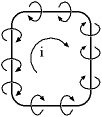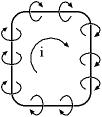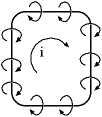3. How many grams of glucose must be added to .5kg of water to raise the boiling point by .1 degrees C, given that the value of i is 1 and the value of Y for glucose is roughly equal to that of formic acid?
Answer B. 15 Grams
Explanation
B is the best answer. Glucose is most like formic acid of all the compounds listed in the Table 1. Neither compound dissociates in water to a significant extent (although formic acid undergoes about 1% dissociation, which we can regard as negligible), resulting in an i-value of 1 for each. A 1.0 molal solution of formic acid is shown in Table 1 to have a boiling point of 100.6˚C, so a 0.16 molal solution (one-sixth molal) would have a boiling point elevated by 0.1˚C. To form a 0.16 molal solution in water with 0.50 kg of water, one-twelfth of a mole of glucose must be added. We ultimately need to determine the mass of glucose necessary to make one-twelfth of a mole. The molecular mass of glucose is 180 grams per mole, meaning that one-twelfth of a mole of glucose has a mass of 15 grams, choice B. You could also get the right answer by working backwards from the answer choices. For instance, consider choice D: 180 g of glucose is equal to one mole of glucose, which when added to 0.50 kg of water results in a 2.0 m solution. By comparison to 1.0 m formic acid in Table 1, we can estimate that the boiling point of a 2.0 molal glucose solution would be around 101.2 ˚C. The same reasoning eliminates choices A and C. The best answer is B.
18.Which of the following drawings accurately depicts the direction of flow in the magnetic field generated by a current (i) flowing clockwise through a wire loop?
A.

A is the best answer. The problem on this question is that the pictures can play tricks on your mind, much like a drawing by the late M. C. Escher, a famous Dutch graphic artist. We can start by noting that the arrows must all curl in the same direction, either pointing into the page within the loop or pointing out of the page within the loop. Choices C and D can be eliminated, because they are a mixture of arrows rather than all the same type. We now must decide between choice A and choice B. This is a case for the right-hand rule: Placing your right thumb in the direction of the current results in your fingers curling in the direction of the magnetic field. Choice A represents the magnetic field that is generated by a clockwise current while choice B represents the magnetic field that is generated by a counterclockwise current. Choice A is the best answer, if you follow your fingers from knuckles to fingertips at each of the points along the loop. The best answer is A.
B.

C.

D.

Usually the right hand rule problems are pretty easy but this one i cant really see how they got A. If someone who has TBR 5 physical can explain, I'd really appreciate it!
Answer B. 15 Grams
Explanation
B is the best answer. Glucose is most like formic acid of all the compounds listed in the Table 1. Neither compound dissociates in water to a significant extent (although formic acid undergoes about 1% dissociation, which we can regard as negligible), resulting in an i-value of 1 for each. A 1.0 molal solution of formic acid is shown in Table 1 to have a boiling point of 100.6˚C, so a 0.16 molal solution (one-sixth molal) would have a boiling point elevated by 0.1˚C. To form a 0.16 molal solution in water with 0.50 kg of water, one-twelfth of a mole of glucose must be added. We ultimately need to determine the mass of glucose necessary to make one-twelfth of a mole. The molecular mass of glucose is 180 grams per mole, meaning that one-twelfth of a mole of glucose has a mass of 15 grams, choice B. You could also get the right answer by working backwards from the answer choices. For instance, consider choice D: 180 g of glucose is equal to one mole of glucose, which when added to 0.50 kg of water results in a 2.0 m solution. By comparison to 1.0 m formic acid in Table 1, we can estimate that the boiling point of a 2.0 molal glucose solution would be around 101.2 ˚C. The same reasoning eliminates choices A and C. The best answer is B.
18.Which of the following drawings accurately depicts the direction of flow in the magnetic field generated by a current (i) flowing clockwise through a wire loop?
A.

A is the best answer. The problem on this question is that the pictures can play tricks on your mind, much like a drawing by the late M. C. Escher, a famous Dutch graphic artist. We can start by noting that the arrows must all curl in the same direction, either pointing into the page within the loop or pointing out of the page within the loop. Choices C and D can be eliminated, because they are a mixture of arrows rather than all the same type. We now must decide between choice A and choice B. This is a case for the right-hand rule: Placing your right thumb in the direction of the current results in your fingers curling in the direction of the magnetic field. Choice A represents the magnetic field that is generated by a clockwise current while choice B represents the magnetic field that is generated by a counterclockwise current. Choice A is the best answer, if you follow your fingers from knuckles to fingertips at each of the points along the loop. The best answer is A.
B.

C.

D.

Usually the right hand rule problems are pretty easy but this one i cant really see how they got A. If someone who has TBR 5 physical can explain, I'd really appreciate it!
